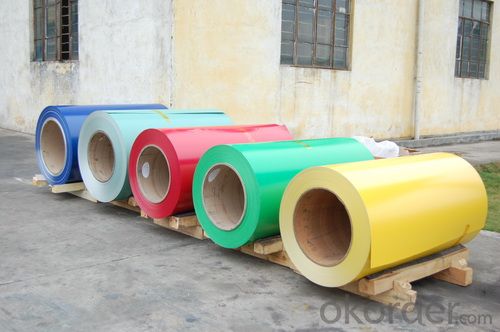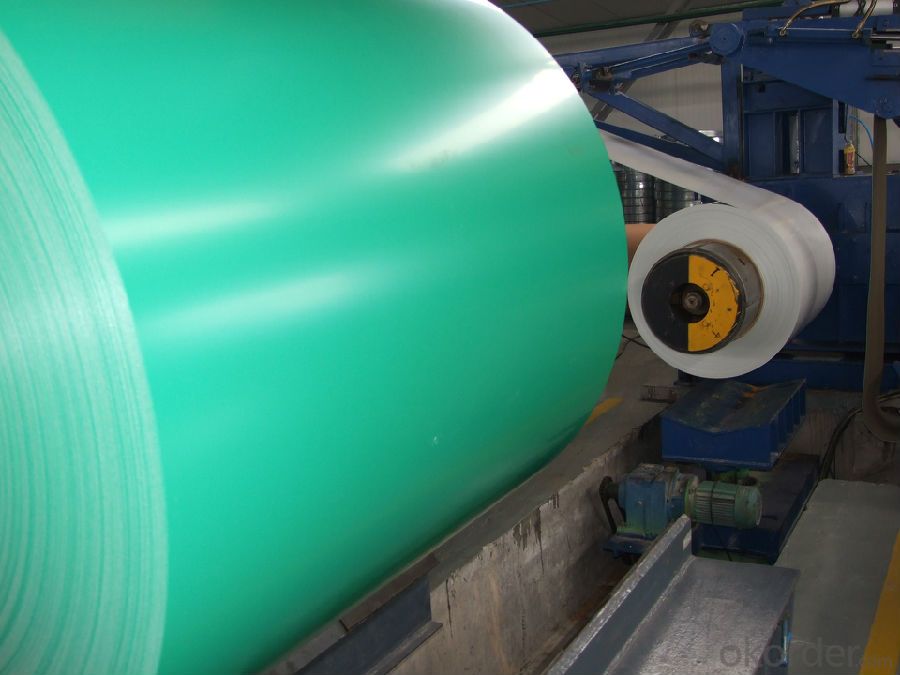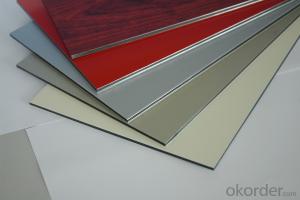Aluminium Composite Pannel for Curtain Wall
- Loading Port:
- Shanghai
- Payment Terms:
- TT OR LC
- Min Order Qty:
- 8 m.t.
- Supply Capability:
- 1000 m.t./month
OKorder Service Pledge
OKorder Financial Service
You Might Also Like
Item specifice
Structure of Aluminium Composite Pannel for Curtain Wall Description:
Coated aluminum coil/sheet are of a wide range of colors, which gives wonderful appearance no matter in residential and commercial constructions of great exhibition centers.
The coated aluminum coil/sheet have been widely used in the fields of construction and decoration( garage doors, ceiling etc.), electronic appliances, lighting decoration, air-condition air pipes, sandwich panels and drainages etc.
Main Features of the Aluminium Composite Pannel for Curtain Wall:
1) High flexibility
2) Impact resistance
3) Excellent weather-proof durability
4) Anti-ultraviolet
5) High erosion resist
Images of the Aluminium Composite Pannel for Curtain Wall:



Aluminium Composite Pannel for Curtain Wall Specification:
Alloy | A1100,A3003,A1050,A8011 etc |
Temper | H16,H18,H24 |
Thickness | From 0.024mm to 1.2mm |
Width | Standard width:1240mm |
Special width:1300mm,1520mm,1570mm,1595mm | |
Diameter | Standard dia:1200mm |
Interior dia:150mm,405mm,505mm | |
Weight | 2.5 T/coil,3.0 T/coil |
Coating | PE, PVDF, AC |
Surface | Embossed, mill finish, coated |
Color | AS to code RAL |
Gloss | 10-90%(EN ISO-2813:1994) |
Coating Thickness | PE: more than 18 micron |
PVDF: more than 25 micron | |
Coating Hardness (pencil resistance) | More than 2h |
Coating adhesion | 5J(EN ISO-2409:1994) |
Impact Resistance | No peeling or cracking(50 kg/cm,ASTMD-2794:1993) |
Flexibility (T-bend) | 2T |
MEK resistance | More than 100 |
FAQ Aluminium Prepaited Coil:
a.What is monthly capacity
---CNBM is one stated own company and our monthly capacity is about 2000tons.
b. Now which countries do you export your goods?
---Now we export to South East Asia,Africa, North America,South America ect.
- Q:What are the common applications of aluminum sheets in construction?
- Aluminum sheets have various applications in the construction industry due to their unique properties and versatility. Some of the common applications of aluminum sheets in construction include roofing, siding, and cladding. Aluminum sheets are lightweight yet durable, making them ideal for roofing applications as they can withstand harsh weather conditions, such as strong winds and heavy rainfall, without corroding or deteriorating. In siding applications, aluminum sheets are commonly used due to their ability to resist rust and corrosion. They provide an aesthetically pleasing finish to buildings, enhancing their overall appearance. Additionally, aluminum sheets can be easily shaped and bent to fit the desired design, making them suitable for curved or intricate architectural designs. Cladding is another common application of aluminum sheets in construction. Aluminum cladding is used to cover the exterior walls of buildings, providing insulation and protection against weather elements. It helps to reduce the energy consumption of buildings by acting as a thermal barrier, keeping the interior cool in summer and warm in winter. Aluminum cladding is also fire-resistant, making it a safe choice for construction projects. Moreover, aluminum sheets are frequently used in the construction of windows and doors. Their lightweight nature makes them easy to handle and install, while their strength ensures durability and longevity. Aluminum sheets can be powder-coated or anodized, allowing for a wide range of color options to suit different architectural styles and preferences. Overall, the common applications of aluminum sheets in construction encompass roofing, siding, cladding, windows, and doors. Aluminum's lightweight, durable, and corrosion-resistant properties make it an excellent choice for various construction projects, providing both functional and aesthetic benefits to buildings.
- Q:Can the aluminum sheets be used for manufacturing ventilation systems?
- Yes, aluminum sheets can be used for manufacturing ventilation systems. Aluminum is a lightweight and corrosion-resistant material, making it a suitable choice for ventilation systems. Its high thermal conductivity allows for efficient heat transfer, making it ideal for applications where temperature control is necessary. Additionally, aluminum is easily formable, allowing for the creation of complex shapes and designs required for ventilation systems. Overall, aluminum sheets are a popular and practical choice for manufacturing ventilation systems.
- Q:What are the different fabrication methods used for aluminum sheets?
- Some of the different fabrication methods used for aluminum sheets include rolling, extrusion, casting, and stamping.
- Q:there is a magnet for other type of nails except aluminum nails
- sadly, magnets do not work on aluminum, however, the are light enough, to be picked up by a vacuum.
- Q:Can aluminum sheets handle high temperatures?
- Certainly! High temperatures are well-tolerated by aluminum sheets. With a melting point of 660 degrees Celsius (1220 degrees Fahrenheit), aluminum proves itself suitable for various applications requiring elevated temperatures. Furthermore, aluminum possesses exceptional thermal conductivity, enabling rapid heat dissipation. This attribute renders aluminum sheets ideal for deployment in environments necessitating resistance against high temperatures, including engine components, heat exchangers, and oven linings. Nevertheless, it is crucial to take into account the specific alloy and thickness of the aluminum sheet, as different alloys may impose different temperature thresholds.
- Q:Can aluminum sheets be used for electronic devices?
- Indeed, electronic devices can utilize aluminum sheets. The electronics industry extensively employs aluminum owing to its commendable conductivity, lightweight structure, and remarkable resilience. It is frequently employed in diverse capacities, including enclosures for electronic elements, heat dissipation systems, and electrical connectors. Aluminum sheets can be effortlessly shaped into various dimensions and configurations, rendering them adaptable for a broad array of electronic devices. Moreover, aluminum emerges as a cost-efficient material, fostering its allure to electronics manufacturers.
- Q:What does aluminum plate "1060-H24" mean?
- Four, H24 H said the work hardening of the state, and some do not have H but T said it is heat treatment.24 machining process control hardness and other properties, in addition to 24 and 12, 14, 16, 18, 22, 26, 34, 36 and so on, usually at the end of 4 is a semi hard state.1060O, 1060-H22, 1060-H24, 1060-H18 state is arranged from soft to hard.
- Q:a dream I had where the carbon element was extracted from aluminum and ploished it became transparent, it was bendable and you could puncher it with out breaking it ?
- Aluminium is an element! Elements are pure substances, therefore aluminium doesn't contain any carbon. What do you mean?
- Q:I have to wire solar DC photovoltaic panels and have always used at least an 8 gauge wire. Recently, I installed a solar electric fence and they recommended special electric fence wire that can handle 10,000 volts. It looks aluminum. The fence techs told me copper is only rated for 600 volts. And the power will leak through the insulation. They also say copper will corrode and created insulated spots. Does this mean that aluminum doesn't corrode and is it superior to copper? Is is all a lobbying scam to force us to buy copper? Can I use the electric fence wire in my solar wiring?
- yes copper wire is better than almunium since coppe is very best conductor that that of almunium
- Q:What are the different methods of finishing aluminum sheet edges?
- Depending on the desired outcome and application, there are multiple techniques available to finish aluminum sheet edges. One option is deburring, which involves removing sharp or rough edges from the aluminum sheet. This can be accomplished with tools like files, sandpaper, or specialized deburring machines. Deburring not only enhances the appearance of the edges but also helps prevent potential injuries or accidents caused by sharp edges. Another method is chamfering, where a beveled edge is created on the aluminum sheet. This can be done using chamfering tools or by carefully filing or sanding the edges at a specific angle. Chamfering is often performed to improve the aesthetics of the aluminum sheet and make it easier to handle and assemble. Additionally, edge rounding is a technique that involves smoothing the edges of the aluminum sheet to give them a rounded or curved profile. Sanders, grinders, or specialized edge rounding machines can be used for this purpose. Edge rounding not only enhances the visual appeal of the aluminum sheet but also reduces the risk of injury from sharp edges. Moreover, anodizing is a widely used finishing method for aluminum sheet edges. It involves creating a protective oxide layer on the aluminum surface through an electrochemical process. Anodizing not only improves the corrosion resistance of the aluminum but also offers a range of color options for the edges, allowing for customization and improved aesthetics. Lastly, powder coating is another viable method for finishing aluminum sheet edges. It entails applying a dry powder onto the aluminum surface and then heating it to create a durable and decorative finish. Powder coating provides a wide variety of colors, textures, and finishes, allowing for customization and enhanced visual appeal. In conclusion, the choice of finishing method for aluminum sheet edges depends on factors such as the desired appearance, functionality, and application requirements. It is crucial to consider these factors and seek expert advice to determine the most suitable method for a specific project.
1. Manufacturer Overview |
|
|---|---|
| Location | |
| Year Established | |
| Annual Output Value | |
| Main Markets | |
| Company Certifications | |
2. Manufacturer Certificates |
|
|---|---|
| a) Certification Name | |
| Range | |
| Reference | |
| Validity Period | |
3. Manufacturer Capability |
|
|---|---|
| a)Trade Capacity | |
| Nearest Port | |
| Export Percentage | |
| No.of Employees in Trade Department | |
| Language Spoken: | |
| b)Factory Information | |
| Factory Size: | |
| No. of Production Lines | |
| Contract Manufacturing | |
| Product Price Range | |
Send your message to us
Aluminium Composite Pannel for Curtain Wall
- Loading Port:
- Shanghai
- Payment Terms:
- TT OR LC
- Min Order Qty:
- 8 m.t.
- Supply Capability:
- 1000 m.t./month
OKorder Service Pledge
OKorder Financial Service
Similar products
New products
Hot products
Related keywords





























